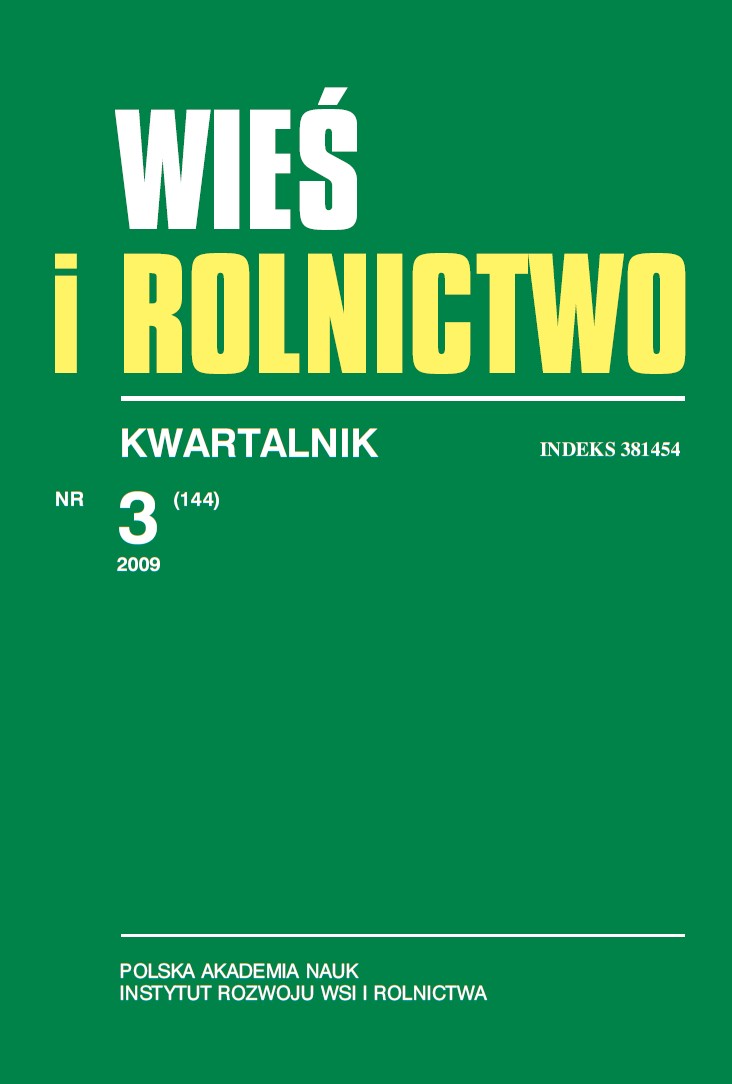Allocation of Resources in Private Farms in Poland in Light of Their Institutional Ties
DOI:
https://doi.org/10.53098/wir.2009.3.144/02Keywords:
institutional structures, allocation of resources, types of production, intensity of institutional tiesAbstract
The aim of this paper was to identify institutional determinants of the allocation of resources in Polish agriculture and its principal production segments (cultivation of field crops, cultivation of fruit and vegetables, the breeding and raising of dairy cows, the breeding and raising of pigs). On the basis of theoretical considerations and nation-wide surveys an aggregate index of the degree of institutionalisation of an agricultural farm was created, which facilitated the delimitation of farms in accordance with the intensity and structure of their ties with institutions. Next, analyses were conducted to establish whether in the identified classes of private farms - characterised by various degrees of intensity and different structure of institutional ties with the environment, the allocation of production factors in the key segments of agricultural production showed essential discrepancies attributable to the influence of institutional structure within which individual farms operated.References
Bludnik I., 2004: The Neoclassical Synthesis – Development or Regress of the Keynesian Theory. In: Research of Contemporary Economic: Issues by Young Economists. Ed. M. Kokocińska. Lubniewice 2002. Wydaw. AE w Poznaniu, Poznań.
Chmielewski P., 1995: Ludzie i instytucje. Z historii i teorii nowego instytucjonalizmu. Instytut Pracy i Spraw Socjalnych, Warszawa.
Czternasty W., Czyżewski B., 2007: Struktury kierowania agrobiznesem w Polsce. Teoria, analiza i tendencje. Wydaw. AEP, Poznań.
Czyżewski A., Matuszczak A., 2006: Rolnictwo Unii Europejskiej i Polski. Studium porównawcze regulatorów i rynków rolnych. Wydaw. AEP, Poznań.
Dopfer K., 1991: Toward a Theory of Economic Institution: Synergy and Path Dependency. „Journal of Economic Issues” 25. DOI: https://doi.org/10.1080/00213624.1991.11505186
Dugger W.M., 1983: The Transaction Cost Analysis of Oliver E.Williamson: A New synthesis? „Journal of Economic Issues” XVII, 1. DOI: https://doi.org/10.1080/00213624.1983.11504090
Hockuba Z., 2001: Nowa ekonomia instytucjonalna – czy zdominuje nasze myślenie w rozpoczynającym się stuleciu? VII Kongres Ekonomistów Polskich, Zeszyt 2, PTE.
Iwanek M., Wilkin J., 1998: Instytucje i instytucjonalizm w ekonomii. Uniwersytet Warszawski, Warszawa.
Jensen M.C., Meckling W.H., 1979: Theory of the Firm: Managerial Behaviour, Agency Costs and Ownership Structure. „Journal of Financial Economics” 10. DOI: https://doi.org/10.1007/978-94-009-9257-3_8
The Legar Kompanion to Institutional and Evolutionary Economics, 1994. Ed. G.M. Hodgson. Edward Legar Publishing Company, Vermont.
Woś A., 2000: Układy strukturalne w rolnictwie chłopskim. IERiGŻ, Warszawa.
Współczesne teorie ekonomiczne, 2005. Red. M. Ratajczak, Wydaw. AE w Poznaniu, Poznań.
Ząbkowicz A., 2003: Współczesna ekonomia instytucjonalna wobec głównego nurtu ekonomii. „Ekonomista” 3.
Downloads
Article file downloads
Pages
How to Cite
Issue
Section
License
Copyright (c) 2009 Wieś i Rolnictwo

This work is licensed under a Creative Commons Attribution 4.0 International License.










